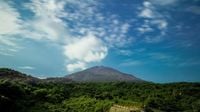Early on Sunday, November 16, 2025, residents of southwestern Japan awoke to the dramatic sight of Sakurajima volcano erupting once again, sending a towering column of ash and smoke up to 4,400 metres into the morning sky. The eruption, which began around 12:57 am at the Minamidake crater, marked the first time since October 18, 2024, that the volcano had produced such a high plume, according to Kyodo News and the Japan Meteorological Agency (JMA).
Located in Kagoshima Prefecture on the southern island of Kyushu, Sakurajima is no stranger to volcanic activity. It is one of Japan's most active volcanoes, and its frequent eruptions are closely monitored by scientists and local authorities. This latest episode, while visually striking and powerful, fortunately resulted in no reported injuries or damage to buildings as of Sunday morning, officials told AFP and Kyodo News.
The explosive eruption at Minamidake crater sent a thick plume of ash and smoke high above the volcano, creating a spectacle visible from miles away. Large volcanic rocks were hurled as far as the fifth station on the mountain, but crucially, no pyroclastic flows—fast-moving currents of hot gas and volcanic material—were detected during the event, Kyodo News reported. Pyroclastic flows are among the most dangerous phenomena associated with volcanic eruptions, capable of devastating everything in their path, so their absence was a relief for local residents and officials alike.
As the eruption continued, the JMA quickly issued an ashfall forecast for parts of Kagoshima, Kumamoto, and Miyazaki prefectures. The agency warned that areas downwind of the volcano could expect moderate amounts of ash, which can cause a range of problems—from reduced visibility and slippery roads to respiratory discomfort and damage to crops. In its advisory, the agency urged residents, "In areas where a moderate amount of ashfall is expected, please take measures to protect yourself from ash, such as using umbrellas or masks, and make sure to drive slowly." This practical advice echoed the lessons learned from previous eruptions, when ashfall disrupted daily life and prompted similar precautions.
Despite the eruption's intensity, the JMA chose to keep the alert level at three on its five-point scale. This level restricts access to the mountain but falls short of the highest warnings, which would require evacuations from nearby communities. The decision reflected both the ongoing nature of the eruption and the absence of immediate threats to populated areas. Level three, as defined by the agency, is a signal for people to stay away from the volcano but does not call for mass evacuations unless conditions worsen.
Sakurajima's history is as dramatic as its present. Once an island, it became joined to the Osumi Peninsula by a massive lava flow during a major eruption in 1914, a geological event that forever altered the landscape of southern Kyushu. Since then, the volcano has been under constant watch, with scientists tracking its activity and local residents living with the knowledge that eruptions are a part of life. The mountain's frequent outbursts have shaped not only the physical environment but also the culture and resilience of the surrounding communities.
Sunday's eruption was not an isolated incident. According to both Kyodo News and the JMA, the volcano erupted several times throughout the day, each event reinforcing the need for vigilance. The agency's ashfall warnings extended beyond Kagoshima to neighboring Miyazaki Prefecture, reflecting the potential for wide-ranging impacts depending on wind and weather conditions. The forecast and real-time updates from the JMA played a crucial role in helping residents prepare and adapt, whether by donning masks, using umbrellas, or altering travel plans to avoid the worst of the ash.
For many in the region, the eruption was a reminder of the delicate balance between the beauty and danger of living near an active volcano. While the sight of a massive plume rising into the sky can be awe-inspiring, it also brings with it the risk of disruption and the need for constant preparedness. The advice from the JMA to drive slowly and protect oneself from ash was heeded by those who have, over generations, learned how to coexist with Sakurajima's fiery temperament.
Local officials in Kagoshima Prefecture confirmed to AFP that, as of Sunday morning, there were no reports of injuries or structural damage, a testament to both the volcano's unpredictable nature and the effectiveness of Japan's disaster preparedness systems. The country is known for its robust early warning networks and public education campaigns, which aim to minimize harm during natural disasters. In the case of Sakurajima, these measures appear to have worked as intended, allowing people to stay safe even as the volcano reminded everyone of its power.
Japan's relationship with its volcanoes is complex and deeply rooted in its geography and history. The country sits on the Pacific Ring of Fire, a region of intense seismic and volcanic activity. As a result, eruptions like the one at Sakurajima are both a scientific subject of fascination and a practical concern for millions of people. Researchers continue to study the volcano's behavior, hoping to improve forecasting models and better understand the triggers for major eruptions.
For now, life in Kagoshima and the surrounding prefectures goes on, albeit with a bit more caution and a layer of volcanic ash settling on rooftops, cars, and fields. The JMA's continued monitoring and the community's resilience ensure that, even in the face of nature's unpredictability, people are as prepared as they can be. As the sun rose over Kyushu on Sunday, the plume from Sakurajima was a stark but familiar reminder of the dynamic forces at work beneath Japan's surface—a spectacle that is both beautiful and, at times, a little frightening.
With no injuries, no damage, and a community well-practiced in responding to the challenges of living near an active volcano, the story of Sakurajima's latest eruption is one of caution, preparedness, and the enduring spirit of those who call this remarkable region home.




